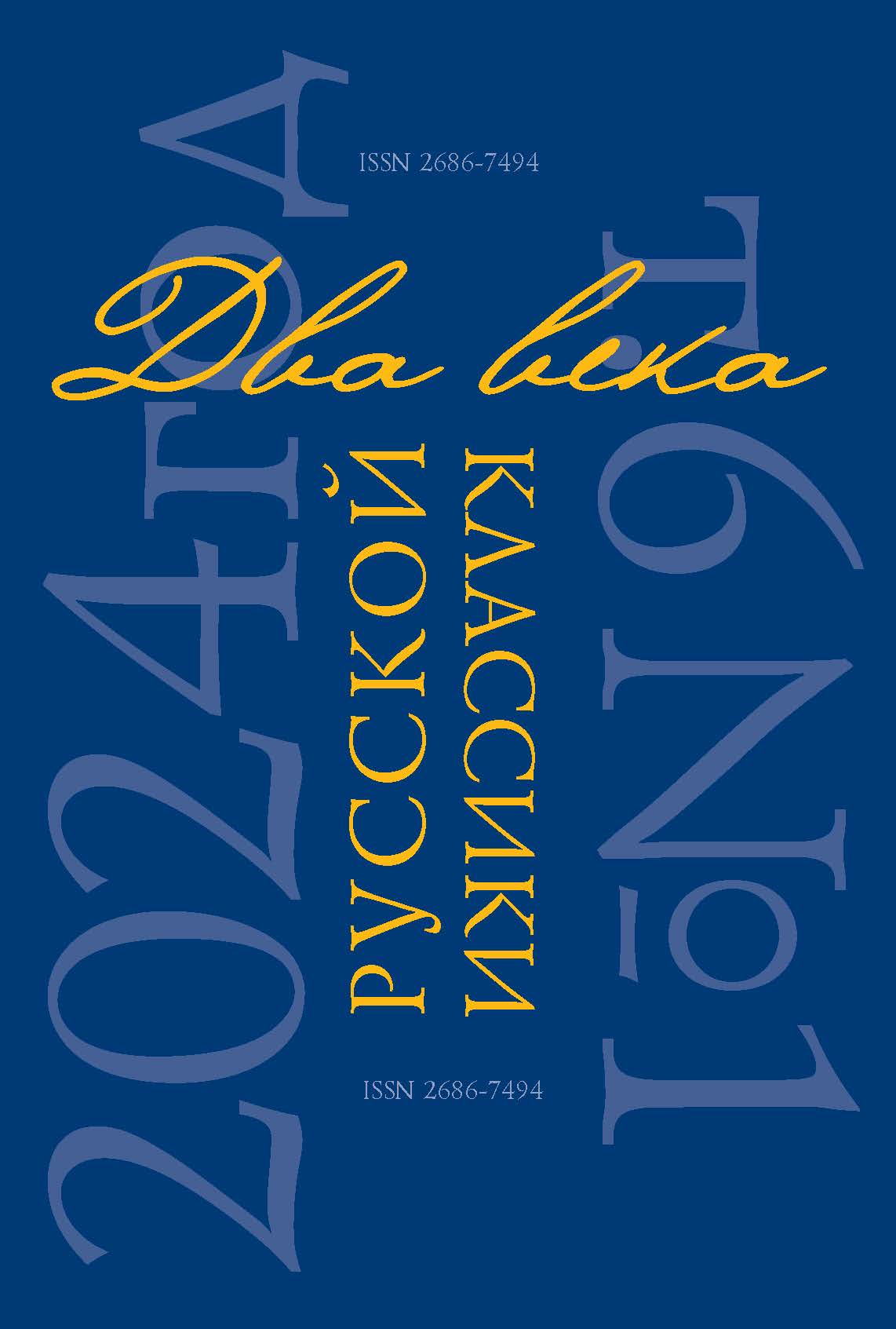Abstract:
The article is devoted to the analysis of the picturesque plot in F. M. Dostoevsky’s novel “Demons,” built around the canvas of the Italian master Raphael Santi, “Sistine Madonna,” in its semantic and symbolic dynamics — the inner spiritual relationship with the fate of Stepan Trofimovich Verkhovensky. The image of Raphael’s Madonna is the most significant element of the ethical and aesthetic system of the character’s worldview, defining the way of thinking and behavior of the character. At the same time, in the conceptual space of the novel, the Sistine Madonna acquires the features of a spiritually ambivalent image: inspiring Stepan Trofimovich to a high way of thinking, she, nevertheless, turns out to be powerless to transform his life. The article analyzes the theological content of the canvas in the context of the Russian tradition (Zhukovsky, Karamzin, Dostoevsky, Bulgakov), which makes it possible to decipher the pictorial code in the fate of Verkhovensky’s father. Spiritual healing and the near-death transformation of the hero become possible thanks to two symbolic and semantic transitions carried out by the Verkhovensky’s father in the final part of the novel: from the Western Catholic “Sistine Madonna” to the Russian Mother of God, from the Western way of thinking and life to the Russian “soil” and Orthodox spirituality.
References
Averintsev, S. S. “ʽTsvetiki milye brattsa Frantsiska’: ital’ianskii katolitsizm russkimi glazami” [“ʽThe Lovely Flowers of Brother Francis’: Italian Catholicism Through Russian Eyes”]. Pravoslavnaia obshhina, no. 2 (38), 1997, pp. 98–105. (In Russ.)
Ashimbaeva, N. T. “Shveitsariia v romanakh ʽIdiot’ i ʽBesy’. K voprosu o poetike toponima u Dostoevskogo” [“Switzerland in the Novels ʽIdiot’ and ʽDemons.’ On the Issue of Dostoevsky’s Poetics of the Toponym”]. Dostoevskii i mirovaia kul’tura [Dostoevsky and World Culture]. St. Petersburg, Serebrianyi vek Publ., 2001, pp. 177–185. (In Russ.)
Bogdanova, O. A. “Spaset li mir krasota? Problema krasoty i zhenskie kharaktery v romannom tvorchestve F. M. Dostoevskogo” [“Will Beauty Save the World? The Problem of Beauty and Female Characters in F. M. Dostoevsky’s Novels”]. Novyi filologicheskii vestnik, no. 1 (28), 2014, pp. 41–69. (In Russ.)
Vetlovskaia, V. E. “Pater Seraphicus” [“Pater Seraphicus”]. Dostoevskii: Materialy i issledovaniia [Dostoevsky: Materials and Research]. Leningrad, Nauka Publ., 1983, pp. 163–178. (In Russ.)
Vladimirova, T. L. “Legenda o Rafaele v russkoi literaturnoi rimliane” [“The Legend of Raphael in the Russian Literary on Rome”]. Vestnik Tomskogo gosudarstvennogo pedagogicheskogo universiteta, no. 8, 2006, pp. 10–13. (In Russ.)
Garicheva, E. A. “F. M. Dostoevskii o preobrazhenii lichnosti v romane ʽBesy’,” [“F. M. Dostoevsky on the Transformation of Personality in the Novel ʽDemons’.”] Znanie. Ponimanie. Umenie, no. 3, 2008, pp. 150–155. (In Russ.)
Dunaev, M. M. Vera v gornile somnenii: Pravoslavie i russkaia literatura v XVII–XX vekakh [Faith in the Crucible of Doubt: Orthodoxy and Russian Literature in the 17th–20th Centuries]. Moscow, Izdatel’skii Sovet Russkoi Pravoslavnoi Tserkvi Publ., 2003. 1055 p. (In Russ.)
Il’chenko, N. M., and S. V. Pepeliaeva. “ʽSikstinskaia Madonna’ Rafaelia v vospriiatii V. A. Zhukovskogo i F. M. Dostoevskogo” [“The Sistine Madonna by Raphael in the Perception of V. A. Zhukovsky and F. M. Dostoevsky”]. Vestnik Viatskogo gosudarstvennogo universiteta, no. 2, 2016, pp. 79–83. (In Russ.)
Kariakin, Iu. F. Dostoevskii i Apokalipsis [Dostoevsky and the Apocalypse]. Moscow, Folio Publ., 2009. 701 p. (In Russ.)
Kasatkina, T. A. “Sofiologiia Dostoevskogo” [“The Sophiology of Dostoevsky”]. Dostoevskii i mirovaia kul’tura: al’manakh [Dostoevsky and World Culture: Almanac]. Moscow, [S. n.], 2003, pp. 71–79. (In Russ.)
Kasatkina, T. A. O tvoriashchei prirode slova. Ontologichnost’ slova v tvorchestve F. M. Dostoevskogo kak osnova “realizma v vysshem smysle” [About the Creative Nature of the Word. The Ontology of the Word in F. M. Dostoevsky’s Works as the Basis of “Realism in the Highest Sense”]. Moscow, Serebrianyi vek Publ., 2004. 480 p. (In Russ.)
Kolpakova, G. Iskusstvo Vizantii. Rannii i srednii periody [The Art of Byzantium. Early and Middle Periods]. St. Petersburg, Azbuka-klassika Publ., 2004. 524 p. (In Russ.)
Krivonos, V. Sh. “B. O. Korman i M. M. Bakhtin: spor ob avtore” [“B. O. Korman and M. M. Bakhtin: The Dispute about the Author”]. Novyi filologicheskii vestnik, no. 1, 2005, pp. 173–181. (In Russ.)
Mochul’skii, K. Dostoevskii. Zhizn’ i tvorchestvo [Dostoevsky. Life and Work]. Paris, YMCA-PRESS Publ., 1980. 561 p. (In Russ.)
Neichev, N. Tainstvennaia poetika F. M. Dostoevskogo [The Mysterious Poetics of F. M. Dostoevsky]. Ekaterinburg, Ural University Publ., 2010. 316 p. (In Russ.)
Gabdullina, V. I. “Arkhetipicheskii motiv ʽDogovora s d’iavolom’ v romanakh F. M. Dostoevskogo: ʽBogootmetnoe Pisanie’.” [“The Archetypal Motif of the ʽContract with the Devil’ in F. M. Dostoevsky’s Novels: ʽThe Divine Scripture’.”] Problemy istoricheskoi poetiki, no. 10, 2012, pp. 133–142. (In Russ.)
Palibrk, V. “Paradigma postmoderna v romane ʽBesy’ F. M. Dostoevskogo” [“The Postmodern Paradigm in the Novel ʽDemons’ by F. M. Dostoevsky”]. Khristianskoe chtenie, no. 6, 2016, pp. 178–188. (In Russ.)
Pomerants, G. S. Otkrytost’ bezdne. Vstrechi s Dostoevskim [Openness to the Abyss. Meetings with Dostoevsky]. Moscow, St. Petersburg, Tsentr gumanitarnykh initsiativ Publ., 2013. 416 p. (In Russ.)
Romanenko, Iu. M. “Metafizicheskoe znachenie poniatiia ʽmetanoia’.” [“The Metaphysical Meaning of the Concept of ʽMetanoia’.”] Metafizika ispovedi. Prostranstvo i vremia ispovedal’nogo slova [Metaphysics of Confession. Space and Time of the Confessional Word]. St. Petersburg, Institute of Human of the Russian Academy of Sciences Publ., 1997, pp. 36–39. (In Russ.)
Rubtsova, N. S. “Zhivopisnyi siuzhet v romane F. M. Dostoevskogo ʽBesy’. Stat’ia pervaia” [“The Picturial Subject in the Novel ʽDemons’ by F. M. Dostoevsky. Part 1”]. Vestnik Udmurtskogo universiteta. Seriia: Istoriia i filologiia, no. 5, 2015, pp. 114–123. (In Russ.)
Rubtsova, N. S. “Zhivopisnyi siuzhet v romane F. M. Dostoevskogo ʽBesy’. Stat’ia vtoraia” [“The Picturial Subject in the Novel ʽDemons’ by F. M. Dostoevsky. Part 2”]. Vestnik Udmurtskogo universiteta. Seriia: Istoriia i filologiia, no. 2, 2016, pp. 5–13. (In Russ.)
Sadaesi, I. “Slavianskii fol’klor v proizvedeniiakh F. M. Dostoevskogo: ʽZemlia’ u Dostoevskogo: ʽMat’ syra zemlia’ — ʽBogoroditsa’ — ʽSofiia’.” [“Slavic Folklore in F. M. Dostoevsky’s Works: Dostoevsky’s ʽEarth’: ʽMother Damp Earth’ — ʽThe Virgin’ — ʽSofia’]. Japanese Contribution to the Ninth International Congress of Slavists. Kiev, September 7–13, 1983. Tokio, Japanese association of slavists, 1983, pp. 80–81. (In Russ.)
Statkevich, I. A. “Proektsiia i interpretatsiia v strukture khudozhestvennogo proizvedeniia” [“Projection and Interpretation in the Structure of a Work of Art]. Vestnik Buriatskogo gosudarstvennogo universiteta, no. 6, 2010, pp. 287–292. (In Russ.)
Syromiatnikov, O. I. “Antikhrist v romane F. M. Dostoevskogo ʽBesy’.” [“The Antichrist in F. M. Dostoevsky’s Novel ʽDemons’.”] Vestnik Viatskogo gosudarstvennogo universiteta, no. 4, 2014, pp. 112–121. (In Russ.)
Khaidegger, M. Istok khudozhestvennogo tvoreniia. Izbrannye raboty raznykh let [The Origin of Artistic Creation. Selected Works from Different Years]. Moscow, Akademicheskii proekt Publ., 2008. 527 p. (In Russ.)









